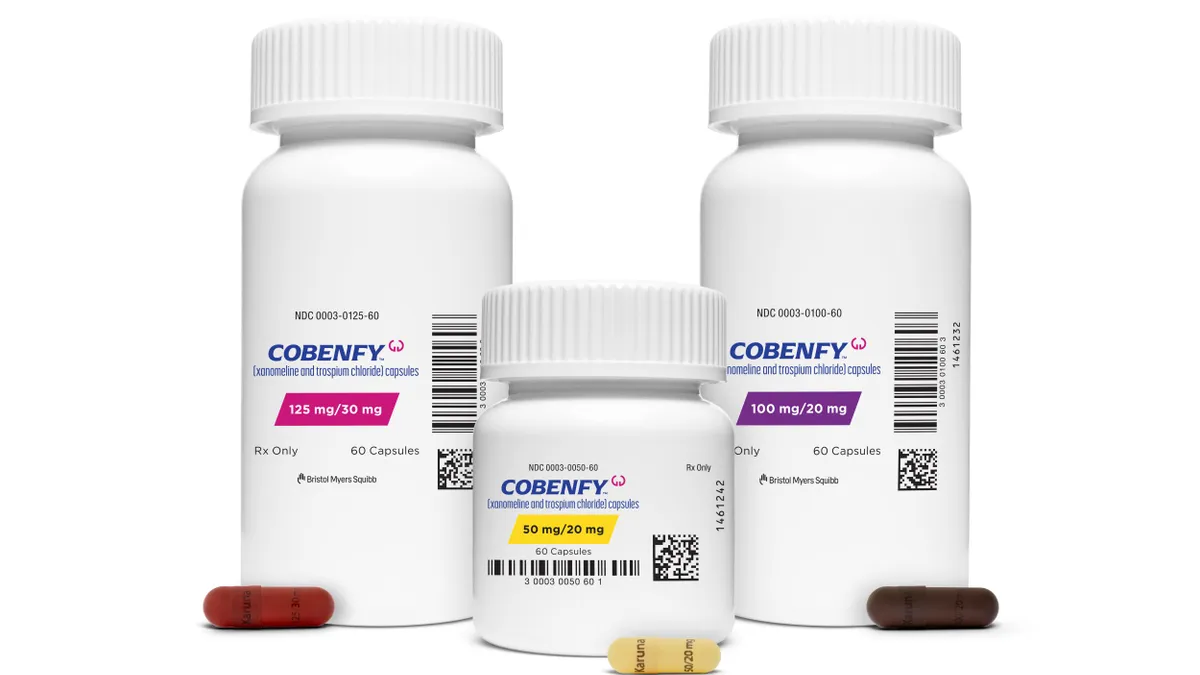The adoption of artificial intelligence (AI) is rapidly taking hold across global businesses, including the life-sciences industry. AI is typically defined as the ability of a machine to perform cognitive functions associated with human minds, such as perceiving, reasoning, learning, and problem solving. AI also includes a range of capabilities to solve business problems. According to a new McKinsey Global Survey on the topic, which addressed nine capabilities in particular, nearly half of respondents said their organizations have embedded at least one AI capability into their standard business processes. Another 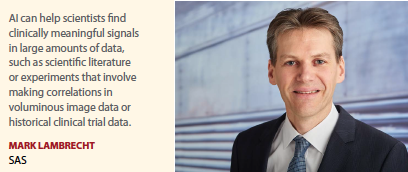 30% report piloting the use of AI. Yet, overall, the business world is just beginning to harness these technologies and their benefits. Most respondents whose companies have deployed AI in a specific function report achieving moderate or significant value from that use, but only 21% of respondents report embedding AI into multiple business units or functions. Indeed, many organizations still lack the foundational practices to create value from AI at scale — for example, mapping where their AI opportunities lie and having clear strategies for sourcing the data that AI requires.
30% report piloting the use of AI. Yet, overall, the business world is just beginning to harness these technologies and their benefits. Most respondents whose companies have deployed AI in a specific function report achieving moderate or significant value from that use, but only 21% of respondents report embedding AI into multiple business units or functions. Indeed, many organizations still lack the foundational practices to create value from AI at scale — for example, mapping where their AI opportunities lie and having clear strategies for sourcing the data that AI requires.
Life-sciences executives note that AI will allow their companies to derive previously unavailable insights and provide different ways for them to look at their data. AI is expected to positively disrupt many of pharma’s business areas and processes — from smarter drug candidate identification and repurposing older products to faster clinical trial recruitment and improved clinician/patient education and support to improving commercialization strategies from sales calls to patient adherence and providing ways to make quicker, better-informed decisions along the path to market and beyond.
In this month’s forum, we examine the many ways that AI will impact the life-sciences industry from molecule to market — all in the pursuit of bringing better care to the ultimate stakeholder: patients.
Impact of AI on Research and Development
With clinical trial failure rates for new drug INDs continuing to hover around 90%, and the average cost to bring a new drug to market at more than $2.5 billion according to the Tuft’s Center for the Study of Drug Development, pharmaceutical companies are eager to find a more efficient way to develop therapeutics.
Recent advances in AI hold the potential to resolve this ominous trend. As a sign of the growing interest in 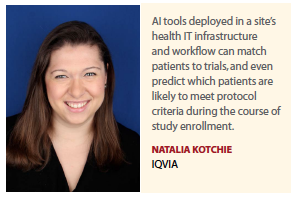 AI-based healthcare solutions, more than 100 startup companies using AI to develop biomedical products have emerged since 2014, with almost all existing large cap companies initiating AI development programs in an attempt to keep up.
AI-based healthcare solutions, more than 100 startup companies using AI to develop biomedical products have emerged since 2014, with almost all existing large cap companies initiating AI development programs in an attempt to keep up.
AI has received a lot of press of late and its possibilities are generating a great deal of excitement. The reality, experts say, is that AI has been around for decades, but several trends over the last few years are now providing biopharmaceutical R&D with real opportunities.
First, the availability of data has increased.
“As data set sizes explode, AI gets better at doing its job because the more data there are to examine, the better the quality of predictions," says Andrew A. Radin, CEO and co-founder, twoXAR. “The massive amounts of data and decreased cost of generating these data will only improve AI utility over time."
A second trend is the decreasing cost of computing, which has happened exponentially over time. The AI of today would not have been economically feasible 10 years ago. Costs will continue to decrease, and computing will become easier through more sophisticated technology.
AI has the potential to enhance both patient care and industry profitability by reducing R&D costs and improving drug lead and drug target quality and clinical trial outcomes.
R&D is, at many levels, a hunt for the needle in a haystack — a gamble on compounds and targets with high costs for failures and enormous windfalls for successes, says Nathan Buchbinder, chief product officer, Proscia.
“AI has the ability to dramatically reduce the uncertainty that there is in both early- and late-stage drug 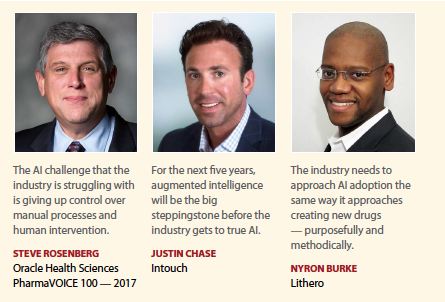 discovery and development, radically shifting the odds of finding success," he says. “This stems from AI’s ability to recognize patterns in data that otherwise remain hidden."
discovery and development, radically shifting the odds of finding success," he says. “This stems from AI’s ability to recognize patterns in data that otherwise remain hidden."
A key benefit of AI technology is that it helps combat human bias, Mr. Radin continues.
“People can inspect information and draw conclusions, but humans don’t have the capacity to examine every data point."
Mr. Radin says AI can help companies choose programs with the greatest chance of success. “There’s a huge pipeline of programs that are being developed and not all of them are going to be successful," he says. “One goal of AI is to figure out which programs are likely to be successful by helping scientists make less risky decisions earlier on the process. One of the greatest impacts AI can have is by helping drug developers chose programs for their pipeline with higher probability of success from the start."
Mr. Radin says there is a lot of confusion about what AI is and what it does. “AI itself is a set of tools that allow someone to predict an event. It doesn’t necessarily provide 100% confidence, but it does allow for the ability to better analyze data and information to make decisions with higher confidence and to certainly to do that better than with just human analysis alone."
Andrew M. Radin, chief marketing officer of twoXAR, says there’s no magic behind AI. “It’s a method of using real-world data and analyzing it. The benefit is that it’s faster and more accurate. It’s cheaper to run computational analysis than to run years and years of wet lab studies. If we can get to a better answer by using computers, that’s a good starting point for us."
The pharmaceutical industry, while slow to change, is beginning to recognize the power of AI as companies achieve some success. “AI will turn R&D on its head; the prior methods for conducting research and navigating through development will change to such a degree that in five years the way we approach even thinking about the next areas of opportunity will change," says Katherine Merton, Ph.D., head, JLABS @ NYC-Boston-Philadelphia. “The step-wise serial process of R&D will change to be hyper-iterative and integrated so that real-world information coming back from development will, in real time, change the areas of research that are being conducted."
Pharmaceutical and biopharmaceutical companies are teaming up with each other and with companies that are developing AI capabilities. Companies such as Amgen, Pfizer, Novartis, Sanofi, GlaxoSmithKline, and Merck have all announced partnerships with AI startups aiming to discover new drug candidates for a range of diseases, including oncology and cardiology.
Amgen is in a test-and-learn phase with AI implementation, says Mike Nohaile, Ph.D., senior VP, strategy, commercialization and innovation, Amgen.
“We are mostly using AI technologies to augment the work of our scientists and clinicians," Dr. Nohaile says. “One example of a project we are working on is a natural language processing application that helps our scientists search the literature and their own data better."
He adds that Amgen is using machine vision applications to help scientists more rapidly process images such as those from electron micrographs. This means the computer does a first visual inspection.
“On the clinical side, we have invested heavily in real-world data and advanced analytics to better predict 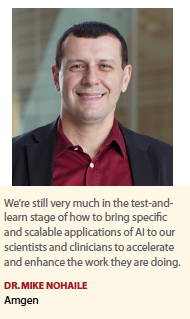 what sites work better with patients and to better predict pharmacokinetics and pharmacodynamics of drugs," Dr. Nohaile says. “We’re also working on ways for AI to help our chemists select new compounds. It’s not yet ready for prime time, but it’s close."
what sites work better with patients and to better predict pharmacokinetics and pharmacodynamics of drugs," Dr. Nohaile says. “We’re also working on ways for AI to help our chemists select new compounds. It’s not yet ready for prime time, but it’s close."
In September 2018, Amgen announced a partnership with GNS Health and the Alliance for Clinical Trials in Oncology to use AI and simulation technology to analyze combined clinical trial data of metastatic colorectal cancer to better understand patient responses to Amgen’s drug panitumumab.
Another Amgen collaborative pilot program aims to better diagnose osteoporotic fractures. The training of the machine and deep learning algorithms takes place by exposing the algorithms to very large data sets. In this case, the data sets are many thousands of radiological images. “It is our hope that this approach will lead to improved diagnosis and ultimately a reduction in secondary fracture risk," Dr. Nohaile says. Based on the advanced experimental work he is leading in AI, he says Amgen hopes to have even greater clarity on its ROI; the early signs are promising.
“Like many things, AI may be slightly overhyped about where we as an industry are going to be in a year or two," Dr. Nohaile adds. “But I think AI is going to bring a profound change. If we allow machines to do fairly repetitive tasks with the goal to concentrate scientists’ time on the activities that matter to enhance the entire process, I see AI improving each of the steps along the way, which can impact the speed, cost, and quality of research. AI will make research faster and cheaper allowing for human creativity."
Several companies that are developing AI for healthcare applications have come together to form a global organization to educate and advocate for policies and regulations to promote rapid integration and use of AI in healthcare.
The Alliance for Artificial Intelligence in Healthcare (AAIH) is a coalition of technology developers, pharmaceutical companies, and research organizations that have expressed the common goal of realizing the potential for AI.
“Many of the leaders in the AI community and drug discovery recognize the value and utility of a multistakeholder organizational model," says Annastasiah Mudiwa Mhaka, Ph.D., Adjuvant Partners, one of the firms leading the launch of AAIH. “We are at a juncture in the evolution of AI in the healthcare sector in which companies in this space now need a coordinated and well-organized advocacy effort that looks at all of the regulatory issues companies will be facing and are currently addressing as well as the need for standards and accreditation."
The R&D process generates more data than ever. A study by Healthcare Executive Group (HCEG) found that the biggest challenge for healthcare leaders in 2018 was leveraging clinical and data analytics. They cited three broad-reaching issues of major importance: wrangling large data sets, working across data silos, and extracting data that are meaningful to different segments of customers.
AI can help scientists to find clinically meaningful signals in large amounts of data, such as scientific literature or experiments that involve making correlations in voluminous image data or historical clinical 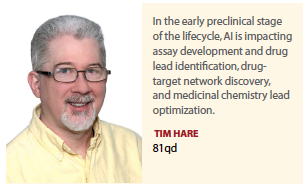 trial data. AI enables them to find the needle in the haystack, says Mark Lambrecht, director of the health and life sciences global practice, SAS. “This is how AI can help support the decisions that scientists and clinicians are making in the pharmaceutical industry," he says.
trial data. AI enables them to find the needle in the haystack, says Mark Lambrecht, director of the health and life sciences global practice, SAS. “This is how AI can help support the decisions that scientists and clinicians are making in the pharmaceutical industry," he says.
In fact, industry experts believe that AI has the potential to impact the greatest areas of challenge in R&D.
The market opportunity for AI in pharmaceutical R&D is substantial. In 2016, the pharmaceutical industry spent some $157 billion on R&D, and this figure is set to increase to more than $180 billion by 2022. A recent McKinsey Global Institute discussion paper suggests that AI has the potential to create between $3.5 trillion and $5.8 trillion in value annually, with a significant portion of that growth in the life-sciences and healthcare verticals.
Furthermore, Gartner recently projected that the global value of AI as a business could reach $1.2 trillion by 2018 and $3.9 trillion by 2022.
AI’s Impact on Drug Discovery
Starting in the preclinical stage, within drug discovery, AI can help identify drug candidate molecules that are both safe and effective, says Natalia Kotchie, VP and enterprise head, clinical development solutions, IQVIA.
“One of the challenges with drug discovery today is that hundreds or thousands of compounds must be screened and optimized against different properties; there are often trade-offs between potency and toxicity," she says. “AI techniques can help optimize across these tradeoffs, helping to optimize selection of compounds and by predicting and optimally trading off these factors."
In addition, Ms. Kotchie says for existing molecules, AI can help to identify new potential indications. Even at the early stages, AI can help to prioritize molecules based on simulated trial outcomes, including treatment effect and variations by niche patient populations.
In the early preclinical stage of the lifecycle, AI is impacting assay development and drug lead identification, drug-target network discovery, and medicinal chemistry lead optimization, says Tim Hare, VP, head of data science, 81qd.
“Assay development has been made more robust by being coupled with AI-based virtual screening, which predicts the drugs and drug features that are good leads and reduces lead identification error rates," he says. “AI can interpret complex imaging assays, leading to validation of drug targets and a more robust understanding of drug-target interactions across interlinked biochemical networks. Virtual screening is becoming more powerful as scientists discover better feature engineering methods that generate higher quality inputs for better modeling."
Mr. Buchbinder says AI is the ideal solution for early-stage compound targeting.
“At the early stage of pharmaceutical drug discovery, tens or hundreds of thousands of compounds go through high-throughput testing to determine which one should get pulled forward for further evaluation," he says. “This process of elimination is aimed at driving the focus of development spending on a select few targets. However, this process is bound to miss specific targets."
Mr. Buchbinder says the deployment of AI helps pick up patterns during this early-stage testing that can indicate where something might be missed. “Whether this means finding the target candidate for a specific product pipeline faster or taking data from across the vast R&D efforts of an entire company to  find compounds with unexpected utility outside of a limited target, AI can make sense of the enormous amount of data being created in pharma."
find compounds with unexpected utility outside of a limited target, AI can make sense of the enormous amount of data being created in pharma."
twoXAR is applying AI in the realm of drug discovery to help identify first-in-class molecules. “These are potential medications that have never been explored before from a biological perspective in a given disease area, and then we are ultimately validating these drug candidate predictions in preclinical studies to progress them to IND and beyond. We do this with internal programs and externally with pharmaceutical partners," says CEO Mr. Radin.
The convergence of big data, cloud computing, and AI has allowed twoXAR to build a drug discovery platform that is faster, cheaper, and more accurate than traditional wet-lab based approaches. The company is able to screen compound libraries for efficacy against a disease and identify new drug candidates from available disease data; these drug candidates can be developed or used as tool compounds to elucidate novel biology and create new chemical entities.
The company has launched about a dozen programs that are in different stages of preclinical development and has received a grant from the National Cancer Institute to identify and validate new, first-in-class drug candidates for pancreatic ductal adenocarcinoma. The company also has partnerships, such as one with Adynxx to develop an oral, non-hormonal drug therapy with the potential to address the underlying mechanisms of endometriosis.
AI’s Impact on Clinical Development
KNect365 conducted a survey across clinical trials professionals from within pharma, contract research organizations (CROs), sites, service providers, consultancies, academia, and patient groups to determine what trends are impacting clinical trials. Thirteen percent of respondents said embracing AI in clinical trials was extremely important, and 35% said it was very important, but just 22% said they were above average or best in class in actually using AI in clinical trials.
The majority of AI use-cases and emerging technologies for clinical trials appear to center around three primary applications: patient recruitment, clinical trial design, and clinical trial optimization.
In patient recruitment, AI is being used in practice today to match patients to clinical trials. Sites can use tools that use EMR and other healthcare data to match patients to trial criteria, and predict which patients may meet trial criteria during the enrollment period. This not only helps sites to enroll patients for trials, but more effectively plan the trials they will participate in.
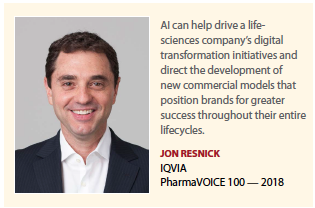 With growing healthcare goals to ensure trial options are available to patients who are eligible, AI is helping to accomplish the goal of more closely integrating clinical research in clinical care and improving healthcare outcomes.
With growing healthcare goals to ensure trial options are available to patients who are eligible, AI is helping to accomplish the goal of more closely integrating clinical research in clinical care and improving healthcare outcomes.
“AI-based screening tools are also being used to identify hot-spots of potential trial candidates, for example in prodromal Alzheimer’s disease," Ms. Kotchie says. “There are a large number of trials being conducted in this indication today, but they suffer from high screen failure rates — 85% — because it is challenging to identify the right candidate patients for the trial. Using a machine learning approach, we are able to predict where patients are who most likely meet the trial criteria, making trial recruitment more efficient. By reducing screen failure rates, this in turn shortens enrollment times and reduces the cost of executing these trials, which tend to be long and expensive to conduct."
Within trial design and planning, IQVIA has developed algorithms to predict the optimal sites for a study. In a retrospective simulation of these algorithms across a portfolio of studies, the analysis showed that if the sites in the studies were selected based on the predicted high performers, enrollment could be up to 24% faster globally.
“AI tools deployed in a site’s health IT infrastructure and workflow can match patients to clinical studies, and even predict which patients are likely to meet protocol criteria during the course of study enrollment," Ms. Kotchie says.
This, she says, can be particularly helpful for sites running multiple trials in a given indication, which therefore must select and recommend the best trial option for a specific patient. Additionally, as drugs are developed for relatively new diseases such as NASH, for preclinical or prodromal disease, or for diseases that are difficult to diagnose, AI-based screening tools can help to narrow down patient populations to the patients most likely to meet trial criteria.
Jim Mulholland, VP, digital and business technology innovation at Syneos Health, says one of the barriers  to getting more subject-eligible entries into a study is the fact that the average person has to travel 35 or 40 miles each way to a site.
to getting more subject-eligible entries into a study is the fact that the average person has to travel 35 or 40 miles each way to a site.
“This is a burden to someone who has a minimum of one visit a week," he says. “It’s even more of problem for patients who have to have more frequent visits for blood draws, measurements, or biometric readings."
Syneos has developed a proprietary methodology that combines various elements to determine a “patient burden" score. “Predictive elements within the data science space can help us design trials to be more patient-friendly," Mr. Mulholland adds.
Syneos is also using machine learning techniques to populate forms and capture data faster during studies and with a lower error rate.
“Anywhere from 70% to 80% of the fields in the EDC systems will be similar, and we are mapping those data to other elements within our data lake or the use of our analytics," Mr. Mulholland says. “We’re training our models to make those mapping determinations automatically for us to save on the time and effort so we can use our time for the other aspects of a trial startup."
He says AI can increase accuracy of the data, avoiding miscodings, or miskeying of data. “Machine learning follows the same instructions every time, so we believe fewer errors will occur and in the end provide a smoother and more expedient outcome in these trials. If we can shave off two or three weeks in the beginning of study startup by enrolling subjects sooner, this brings potential life-changing care to subjects earlier in the process and brings the study to a close potentially earlier, which leads to commercialization sooner."
Ms. Kotchie says AI is helping to optimize clinical trial conduct as well. “Traditionally, sites and investigators have been selected based on historical performance," she says. “Today, more information is available on additional factors that influence success in a clinical trial, such as trial competition and available patients matching trial criteria. These factors must be reconciled, and machine learning techniques are well-positioned to enable these trade-offs to optimize site selection."
AI can also support risk-based monitoring for clinical trials, which can be a costly aspect of executing a trial.
“Analytics help mitigate risk while improving patient safety and optimizing site performance," Ms. Kotchie says. “Algorithms identify sites that are highly likely to show a particular risk behavior, as well as patients who are at risk for non-compliance. With this insight, it is possible to take actions earlier and even avoid potential issues before they occur. Leveraging ML and AI in subject outlier detection can further improve patient safety monitoring."
Safety reporting is mandated and varies by country. With just 15 days to report serious, unexpected occurrences to regulatory bodies, and tens of thousands of events being reported globally on a daily basis, safety teams need tools that can help them curate the data and identify data that are disproportionate to other adverse events reported. AI unleashes the potential of data that already exists but that has been locked away or that no one knows what to do with. Automating this process without human interaction not only saves time and costs, it has the potential to improve patient safety.
The volume of safety cases is increasing, while safety reporting staff is not; this is another reason why AI has such a practical role to play in safety and pharmacovigilance, says Bruce Palsulich, VP, safety product strategy, Oracle Health Sciences.
“For example, nursing call centers commonly exist so patients can call and ask questions or report how 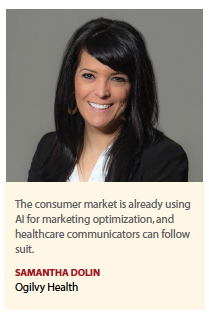 they feel," he says. “With the help of AI, this information could be curated and lead to potential adverse reaction reports that otherwise wouldn’t have been captured. In this scenario, about 90% of the calls have direct reference to adverse effects, so workers must screen 100% of the call logs from the hotline just to see if any of those calls report adverse events. By applying an AI screening process, potential adverse events can be identified with nearly a 99% accuracy rating, which is more accurate and effective than what human staff can accomplish."
they feel," he says. “With the help of AI, this information could be curated and lead to potential adverse reaction reports that otherwise wouldn’t have been captured. In this scenario, about 90% of the calls have direct reference to adverse effects, so workers must screen 100% of the call logs from the hotline just to see if any of those calls report adverse events. By applying an AI screening process, potential adverse events can be identified with nearly a 99% accuracy rating, which is more accurate and effective than what human staff can accomplish."
Steve Rosenberg, senior VP and general manager, Oracle Health Sciences, says drug safety and pharmacovigilance are areas where AI is beneficial and practical today. “Adverse events are reported with structured data and there’s generally a rich historical record of adjudicated events," he says. “That information can be used to train the machine so new adverse events can be adjudicated with a high degree of accuracy. By applying AI to safety data for signal detection, pharmacovigilance teams have capabilities to identify risks earlier and even to mitigate the risk of future drug reactions."
Mr. Palsulich says based on the signal detection work they’ve done to date, it may be possible to leverage machine learning to combine data from multiple sources to predict risk with products early in the lifecycle versus through traditional statistical models.
“AI has the potential to derive insights by combining information from diverse sources such as clinical experience, postmarket experience, electronic medical records, genomic data, pharmacodynamics, and chemical structures," he says.
AI and Commercial Applications
Pharma first started using AI in R&D, drug discovery, and clinical processes. Now, the industry is starting to leverage AI on the commercial end. AI can help to, among other things, make sense out of the massive amounts of data the industry collects. AI analysis can improve commercialization strategies from sales calls to patient adherence and provide ways to make quicker, better-informed decisions along the path to market and beyond.
Major pharma companies — Pfizer, GSK, Novartis, Lundbeck, Takeda, AstraZeneca, and Teva — are using AI to improve marketing efforts for new and existing products. For example, to reenergize Chantix marketing efforts, Pfizer reportedly used public data from the Centers for Disease Control and Prevention and other public data sets and de-identified data to find the segment of patients who had successfully quit smoking. Through the help of AI, Pfizer was able to discover similar patient populations and communicate the benefits of smoking cessation to them.
Other use cases illustrate the benefit of using AI to not only segment patients, but physicians as well.
According to a report by Eularis, use of sales message customization based on AI analytics has been shown to increase prescribing by 43% for sales representatives compared with sales representatives who did not.
AI has begun to have a short-term impact on sales and marketing practices as well as a long-term effect on the marketing landscape. According to JLABS’ Dr. Merton, AI will be able to better process stakeholder aligned information enabling more targeted dissemination of information to the customer. “Marketing costs should decrease in the near term," Dr. Merton says. “The long-term landscape will mean that information coming back from marketing efforts will be instrumental in how companies look at R&D."
However, Lithero CEO Nyron Burke is not sure the industry has it all figured out just yet. “The needle is not moving very fast. The industry likes to give itself credit for AI use, but it isn’t clear how much AI is actually being used on a broad scale," Mr. Burke says. “I don’t think the industry has figured out how to deal with the triple challenges of people, preparation, and patience. It’s going to take time for us to figure these things out, and the industry is going to have to approach AI adoption the same way it approaches creating new drugs — purposefully and methodically."
Mr. Burke sees many applications for AI within the industry, especially since the pharma industry has so much data available that’s consistent in its format; this makes it perfect for an AI approach. “It’s just a matter of companies investing the resources to take that data and marry it with a prescribing AI formula to figure out their trends," he says.
Justin Chase, executive VP of innovation at Intouch, has witnessed some growth within the industry moving from skepticism to acceptance that AI is going to change how pharma markets its products.
“Particularly in the past 12 months, the industry has moved from a collective systemic skepticism to a place where AI will most likely play a very significant role in the way that companies target, in the way that they market to, in the way that they interact and engage with patients, HCPs, and caregivers in the future," Mr. Chase says. “But it’s still in a very nascent space, so the industry is still not quite sure what exactly the future looks like."
On the other hand, Jon Resnick, president real world and analytics solutions at IQVIA, says he has seen multiple examples of the industry leveraging AI on the commercial side.
“Early adopters are already reaping the benefit of using AI and machine learning to drive commercial success," Mr. Resnick says. He provides these examples:
In the United States, one of the top pharma companies used physician-level intelligence uncovered from multichannel marketing optimization activity data to maximize its promotional strategy and implementation. Through a unique targeting, segmentation, and promotional campaign plan focused on optimizing ROI, the company saw incremental sales of $25 million in six months without increasing the cost of its marketing spend.
In Europe, one company used AI and machine learning to uncover the physician responses and preferences regarding digital engagement. With new insights in hand, the company was able to segment physicians and create a tailored physician-level digital engagement strategy and increase email open rates and requests for more product information. Further, a top U.S. company used AI and machine learning for an oncology product for patient disease progression monitoring as well as for bi-weekly identification of treatment-ready patients and their treating physicians. This information helped sales representatives to identify and optimally engage the right treating physicians at the appropriate time with product information.
“AI and machine learning currently allow global life-science marketing, sales, and brand strategy teams to more confidently craft and execute actionable commercialization strategies from newly uncovered insights," Mr. Resnick says. “AI/ML enables life-sciences companies to dig deep into granular layers of HCP, patient, and payer data to reveal previously untapped insights, show actionable predictions, and enable better and faster decision-making."
There is no reason for pharma to hesitate in its adoption of AI at this point, says Samantha Dolin, chief creative officer, Ogilvy Health. The consumer market is already using AI for marketing optimization, and healthcare communicators can follow suit. The old guard, single-platform messaging approach needs to give way to flexible and dynamic messages. AI and programmatic technologies can preserve audience privacy and still deliver timely messaging.
“Healthcare marketing can immediately embrace AI to help refine and adjust messaging in real time against target audiences," Ms. Dolin says. “By testing individual messages against profiles of physician and patient audiences, computers can align interest, context, near- and long-term behaviors, and messaging to create a unique ad for an audience."
Once the industry is fully onboard with AI practices, Mr. Burke sees an incredible short-term potential for streamlining marketing practices, particularly in the realm of marketing regulatory and compliance review. Compliance review is an essential part of the marketing process, but it is labor intensive, repetitive, and incredibly expensive. “The worst part is that it forces smart, creative people to lose countless hours slogging their way through materials when they could be doing innovative work elsewhere," Mr. Burke says. “In the short term, AI can take the drudgery out of the review process, and free up reviewers’ time so they can do the creative, life-saving work they care about."
AI can be used to speed up marketing content delivery and improve content monitoring, but in the long term, AI should take on a greater role in helping with messaging and content creation. “Imagine how much easier it will be for marketers and copywriters to create innovative pieces if they have basic compliant content to build off of," he says. “Faster creation and faster review mean life-saving drugs get to market faster at reduced costs for everyone."
Mr. Burke adds that in the sales realm, AI can be useful for analyzing the landscape and helping sales leaders decide where to put their reps and what type of content would be most impactful in a given area. Currently, answering those questions requires human analytics.
Even though the industry has billions of points of data it collects on its own, companies still need to use third-party vendors to acquire more data because even the largest organizations don’t have all the datasets that they need, says Ariel Katz, co-founder of H1, a live data insights company. These companies need more data, they need a way to make it functional, and they need to use external sources for that data. This requires an AI platform to structure that data into some sort of algorithm.
“The industry is at a point where pharma companies realize that they need to adopt these new technologies, and then implement algorithms and see the changes in terms of workflow," Mr. Katz says. “The impact will be across every function — basic research, preclinical, clinical, medical affairs, commercial, regulatory — and every activity."
AI can determine the right indication to help get to market quicker, especially as many companies are gearing toward technology platforms instead of positioning themselves as small molecule-based companies. “There are algorithms that can be run to help accelerate the strategy component to get drugs to market more quickly when the right decisions are made upfront," Mr. Katz says.
AI Reveals Insights
By leveraging real-world data and AI/ML, life-sciences companies can uncover precise insights. Such insights enable companies to find new opportunities in established approaches, identify new means for competitive differentiation and advantage, and innovatively, quickly, and confidently pivot to address business challenges. “New insights can also be used to create tailored, competitive, and sustainable strategies that impact every stage of the commercial continuum, including prelaunch, launch, maturity, and loss of exclusivity," Mr. Resnick says. “By infusing brand strategies with AI/ML, brand managers extract the greatest optimized value from each stage of a brand’s lifecycle."
AI and machine learning help unlock the power of digital, genomic, and other clinically rich data sources to enable real-time insights and agile response capabilities. AI/ML significantly enhance precision customer engagement approaches, while at the same time, enabling brand teams to execute new strategies with agility, speed, and efficiency.
For example, Mr. Resnick says, a prelaunch brand team could leverage AI/ML to examine patient level data to more deeply understand patient segments and disease progression. At launch, AI/ML can be used to precisely segment and target physicians in order to craft and optimize salesforce strategies.
A mature brand might re-examine its own — and its competitors — multichannel marketing (MCM) promotional strategies to more effectively engage physicians with the right message, channel, and timing. At loss of exclusivity, AI/ML might enable a brand to tap into new revenue streams by examining patient data to uncover patient segments for a fixed combination therapy. For rare diseases, AI/ML can dramatically increase the success rate to find these patients.
“In the long term, AI and machine learning can help to shape and drive a life-sciences company’s digital transformation initiatives and direct the development of new commercial models that position brands for greater success throughout a brand’s entire lifecycle," Mr. Resnick says.
Conversational and Augmented AI
Chatbots and voice assistants are also adding a layer of data to the mix, and AI can help with those, too. As chatbots replace human interactions the challenge for pharma companies is how to direct the output from those discussions to the various groups that need the information, without overloading them with what could be unnecessary information. According to Oracle’s Mr. Palsulich, diverse teams such as medical affairs, drug safety, marketing, patient support, and legal may all be consumers of these chatbot interaction logs. “AI helps solve this issue by doing the sifting and sorting and delivering the relevant information to the right people at the right time," he says.
In the voice assistant space, AI can help get deeper insights from the data gleaned from conversations with Siri, Alexa, etc. Conversational AI enables an innately human form of interaction between people and machines using natural language. For example, Intouch has an AI tool, Cognitive Core, to create a series of conversational AI engagements, which can delve into topic area, which would be specific to a patient population such as MS.
In the context of pharma, these bots or conversational AI can go deeper and can be used for triage. “We could use the data to connect one patient to another, or a patient to an HCP, or a caregiver to a physician, and provide them with resources, tools, and education," Mr. Chase says. “There are other layers of additive value that can be provided in this conversational experience."
Conversational AI will be the next big step for pharma, he predicts. “In particular natural language processing, machine learning, and robotic process automation are the three fields of AI that will proliferate within pharma at the greatest and most expeditious clip," Mr. Chase adds.
Another place AI can have an impact is in search engine optimization (SEO). Historically, SEO has been a very laborious and manual task. But it can be optimized through AI by up to 50%. This is augmented AI, which mean humans will not be completely replaced, Mr. Chase says. “AI solutions are not going to replace a human but rather provide humans with the technology in AI or augmented intelligence to do their jobs better, faster, and more efficiently. For the next five years augmented intelligence is probably going to be the next big steppingstone before we get to true AI, where technology actually replaces human jobs and advances to a degree where narrow AI becomes smarter and more advanced."(PV)
~~~~~~~~~~~~~~~~~~~~~~~~~
Ways AI Can be Used in Commercialization
Automation
Precision Targeting and Segmentation
Faster Reimbursement
Stronger Customer Engagement and Personalized Multi-Channel Marketing
Value Pricing
Patient Adherence
Precision Sales Force Messaging
Source: Eularis
~~~~~~~~~~~~~~~~~~~~~~~~~
Challenges of Implementing AI
Our experts discuss several challenges the industry faces as it begins to use AI in its R&D and commercial endeavors.
 Nyron Burke
Nyron Burke
CEO, Lithero
The industry faces three main challenges in using AI: people, preparation, and patience.
Companies haven’t done a good job of accounting for the human piece. Many people in our society are freaked out by AI, and they can be very resistant to its implementation. Companies will not be able to gain widespread adoption without dealing with the fears and feelings of patients, providers, and employers.
For a company to successfully implement AI, it has to make sure it’s got its data ready and its groundwork laid. This can be a complicated process, especially when companies do not have experience in AI implementation.
In those moments, it helps if executives are humble enough to seek out AI experts and AI-focused companies that specialize in this kind of work. This way, they know what bases they need to cover so they can get the transition right the first time.
Companies often want to go out and buy AI they can implement quickly, but they forget that AI is still an area of research. AI can’t just be pulled off the shelf — there are many pieces that have to be custom-created. This takes time. Then, after the AI is built, it has to be adopted. It takes time to integrate AI into people’s ways of working. It takes time to answer the questions that come with AI implementation: How do we help people change? How do we use this technology? How do we get the data right? These are not easy questions to answer.
 Samantha Dolin
Samantha Dolin
Chief Creative Officer, Ogilvy Health
AI has been represented as a miraculous solution that is a turnkey application of technology. It’s this perception that is the biggest danger — casting doubt and misunderstanding on AI for healthcare. The biggest challenge for healthcare is going to be sourcing and formatting data at scale. AI is at its best when parsing through large sets of data and processing it. For healthcare, the variety of data sources is going to enrich the insights that can be gained. For precommercial applications, this is a straight pathway due to the proprietary nature of product development. For commercial products, this becomes more complex.
Leaving the lab, AI will need to be fed data from real-world scenarios to help shape product refinement, real-world application, and efficacy from patients. This is where complicity in healthcare data sharing is a challenge.
In the United States and most of Europe, healthcare data is a carefully guarded secret for most people. Many patients and physicians regard healthcare data as completely opaque to the world. Data polled from real-world experience from actual patients and practicing physicians will allow larger pools of data for AI to analyze.
The largest danger facing AI is poor diversity and a limited volume of data. Technology such as AI should be a call-to-action for patients to volunteer their anonymized data for computational pooling. Socializing data and allowing analysis beyond controlled data sets will create a new level of insight and open up the possibilities for AI.
 Natalia Kotchie
Natalia Kotchie
VP and Enterprise Head, Clinical Development Solutions, IQVIA
Change management and adoption of tools are some of the great challenges in implementing AI. The challenges in R&D have existed for many years, with different approaches used to try to address them — often with marginal impact. These are complex processes with interdependencies and contradicting information. While innovations can impact one part of the process, the overall impact may be neutral due to many competing forces and dependencies. AI is well-positioned as a tool to help make sense of these complexities. But with the long-standing difficulties in making progress against these challenges, there is inherent skepticism in the industry. This is where change management is critical. AI and ML can enable decision-making, but end users are often not familiar with the techniques or possibilities. As a result, there may be a lack of trust or inherent skepticism in the results. This can be overcome by partnering functional and technical experts to bring greater clarity and understanding. Early adopters and champions from within the impacted business need to provide important leadership and bring their peers along the journey to adopt AI within routine business. Case examples and proof points showing benefits are essential to demonstrating the business value that AI creates in addressing challenges and meeting objectives. Identifying these sources of benefit early, and then providing demonstrative proof of benefit, enables the adoption process.
 Mark Lambrecht
Mark Lambrecht
Director of the Health and Life Sciences Global
Practice, SAS
Companies may try to get a return on investment too soon. Their expectations may be influenced by some of the opinions that they read, and perhaps the successes seen in other industries. They expect there will be a very rapid effect.
Companies that are agile, that can change their processes, that can become more focused on the effect AI will have on the patient will be the most successful at AI implementation.
 Mike Nohaile, Ph.D.
Mike Nohaile, Ph.D.
Senior VP — Strategy, Commercialization, and Innovation, Amgen
One of the biggest hurdles for AI in healthcare will be overcoming inertia to overhaul current processes that no longer work, and experimenting with emerging technologies. AI faces both technical and feasibility challenges that are unique to the healthcare industry. For example, there’s no standard format or central repository of patient data in the United States. The key is to have the right people championing any technology implementation. The difference between success and failure is whether there is human interaction and high-end human thinking around problem solving. It’s better to do pilots properly and learn from those than to try a lot of things that sound cool on the surface.
 Jon Resnick
Jon Resnick
President, Real World
& Analytics solutions, IQVIA
There is a general lack of understanding, and some skepticism, regarding the specific value and the potential that exists for AI and machine learning (ML) when it comes to commercialization within the life-sciences industry. So far, some of the promises of AI and ML seem to have far exceeded the reality in healthcare. There is a great need for more evidence and detail regarding actual AI/ML capabilities and how those capabilities can benefit life-sciences companies.
Harnessing the value of AI/ML across the entire organization requires internal championship, cross-functional engagement, and change management. Some of the most obvious areas where these shifts need to occur include marketing/brand strategy, promotions, sales operations, commercial operations, analytics and IT, working in concert. This is not how most pharma companies currently work. IT, legal, compliance, and privacy teams must support AI/ML adoption before any implementation. AI/ML offerings must be tailored to meet privacy requirements in accordance with U.S., European, and other regional privacy regulations respectively. For successful implementation, pharma needs to provide good training and support to ensure operational adoption and execution.
 Steve Rosenberg
Steve Rosenberg
Senior VP and General Manager,
Oracle Health Sciences
The challenge we see is in giving up control over manual processes and human intervention. We have to learn to trust the outcomes from AI. Clinical teams are going to have to become comfortable with giving up control of manual processes that should be released to smart technology. This will take time. Change is certain but growth is optional. It is happening and AI is already changing other industries. For pharma, we must embrace it.
We also need to deemphasize scoring a home run and focus on gradual base hits. With the application of new technologies in a highly regulated industry, small, incremental wins are a more prudent approach to adoption. Those small wins will add up over time.
Humans carry a certain error rate, and AI brings the potential to reduce that error rate by introducing augmented capabilities. When something does go wrong, signals can be alerted for humans to step back into the process. This symbiotic relationship of checks and balances is key.












